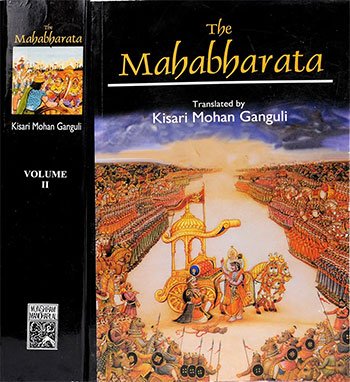Section VII - Regions North and East of Meru: Northern Kurus, Bhadrasva, Jamvudvipa
Book index: Mahabharata (English)
This page contains a summary of the Mahabharata Section VII including examples of moral lessons in daily life. The Maha-Bharata is one of the largest epics ever written containing roughly 100,000 Sanskrit verses. It deals with the legendary history of ancient India and contains a large number of interwoven tales.
Short summary of the chapter:
Dhritarashtra requested Sanjaya to describe the regions to the north and east of Meru in detail. Sanjaya first spoke of the Northern Kurus, where the trees bear sweet fruits, some yielding food of different tastes and milk. The land is abundant with golden sands and the people there are of pure birth, living for ten thousand and a hundred years, always cheerful and free from illness. Twins of opposite sexes are born there, growing up equally, and when they die, they are taken by a class of birds called Bharunda.
Moving on to the eastern side of Meru, Sanjaya described Bhadrasva as the foremost region, with a forest of Bhadra-salas and a huge tree called Kalamra, adored by Siddhas and Charanas. The men there are white complexioned and strong, while the women are beautiful, with moon-like radiance and bodies as cool as moon rays. Their life span is ten thousand years, and drinking the juice of Kalamra keeps them youthful forever. South of Nila and north of Nishadha lies a Jamvu tree, granting every wish and producing a silvery juice when ripe.
Sanjaya then spoke of a fire called Samvataka that always blazes on the summit of Malyavat towards the east. Malyavat itself measures eleven thousand Yojanas, and the men born there are of a gold complexion, fallen from the region of Brahman and utterers of Brahma. They undergo severe ascetic austerities, with their vital seed drawn up and eventually entering the sun for the protection of creatures. Numbering sixty-six thousand, they proceed in advance of Aruna, surrounding the sun, before entering the lunar disc after being heated by the sun's rays for sixty-six thousand years.
Full English translation:
This page is merely a summary which is automatically generated. If you are looking for authentic sources such as the Sanskrit text or the Full English translation of Mahabharata Section VII - Regions North and East of Meru: Northern Kurus, Bhadrasva, Jamvudvipa, have a look at the following articles:
Section VII, online text
English translation by Kisari Mohan Ganguli.
Read this and other chapters online.
Mahabharata (English Summary)
by Kisari Mohan Ganguli | ISBN-10: 8121505933
Buy the latest edition:
FAQ of Mahabharata, Section VII:
What are the characteristics of the Northern Kurus region?
The Northern Kurus region is abundant with sweet fruits, fragrant flowers, and milk-yielding trees. The inhabitants are of pure birth, live for ten thousand years, and are always cheerful.
What is the description of Bhadrasva in the eastern side of Meru?
Bhadrasva is known for its Bhadra-salas forest and the Kalamra tree. The people have white complexions, live for ten thousand years, and remain youthful by drinking the juice of the Kalamra tree.
What is the significance of the Jamvu tree in Jamvudvipa?
The Jamvu tree, towering a thousand and a hundred Yojanas, grants every wish. Its silvery juice, when consumed, brings peace of mind, eternal youth, and produces a rare gold called Jamvunada for celestial adornments.
Daily life: Regions North and East of Meru: Northern Kurus, Bhadrasva, Jamvudvipa:
The story from the epic depicts magical and divine regions beyond our world, describing places of immense beauty and supernatural qualities, inhabited by exceptional beings living in harmony, free from illness, and enjoying longevity. It speaks of miraculous trees that fulfill every need, from nourishing food to beautiful clothes and jewels, emphasizing a connection with nature that provides abundantly. While these fantastical elements may seem far removed from our daily life, they inspire a deeper appreciation for the natural world and the importance of living in balance with it.
Incorporating the essence of this narrative into our lives involves nurturing our connection with nature, acknowledging the sustenance and beauty it offers, and striving to live harmoniously within it. It encourages us to seek wellness, not just through physical health, but also by fostering a peaceful mind and heart, akin to the inhabitants of these divine lands who live free from ailment and despair. Attuning ourselves to the natural cycles, finding contentment in simple pleasures, and valuing relationships over material wealth mirror the virtues of these mythical societies.
Ultimately, the story serves as a metaphor for striving towards an ideal state of being where peace, health, and happiness are paramount. It reminds us to respect and protect our environment, to live with compassion and kindness, and to cherish the bonds we form with others, aiming for a life that, while it may not reach the mystical heights described, is nonetheless enriched with a sense of purpose and joy.
